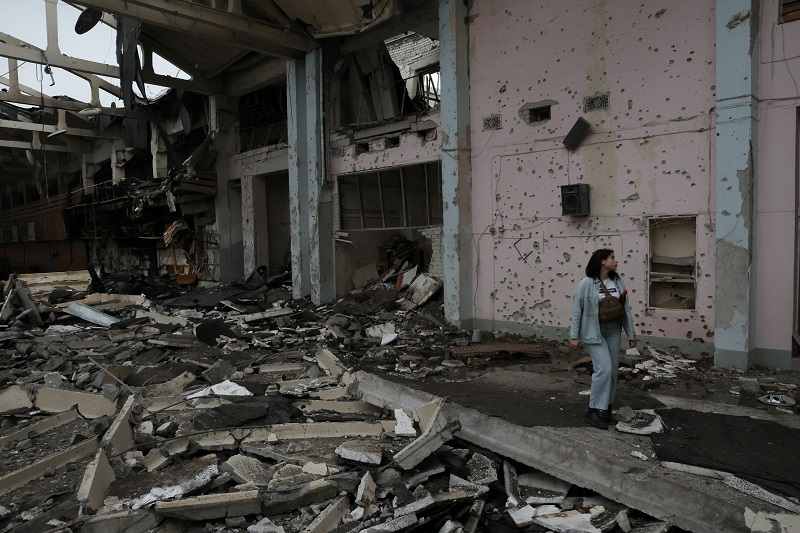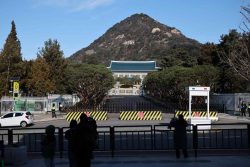
A person surveys the damage after a sports complex of an educational institution was shelled overnight as Russia’s attack on Ukraine continues in Kharkiv, Ukraine, on Friday.
17:24 JST, June 25, 2022
KYIV (Reuters) – Russia launched artillery and air strikes on the twin cities of Sievierodonetsk and Lysychansk on Saturday, hitting a chemical plant where hundreds of civilians were trapped, a Ukrainian official said.
Serhiy Gaidai, governor of the Luhansk region, said Russian forces attacked Sievierodentsk’s industrial zone and also attempted to enter and blockade Lysychansk.
“There was an air strike at Lysychansk. Sievierodonetsk was hit by artillery,” Gaidai said on the Telegram messaging app, adding the Azot chemical plant in Sievierodonetsk and the villages of Synetsky and Pavlograd and others were shelled.
He made no mention of casualties at the Azot chemical plant and Reuters could not immediately verify the information.
Gaidai said 17 people were evacuated on Friday from Lysychansk by police officers, rescuers and volunteers.
Ukraine said on Friday that its troops had been ordered to retreat from Sievierodentsk, a key battleground city, as there was very little left to defend after weeks of intense fighting.
“During the last [several] days, an operation was conducted to withdraw our troops,” Kharatin Starskyi, the press officer of a National Guard brigade, said on Saturday.
Starskyi, who had been in Sievierodonetsk, told morning television that the flow of information about the withdrawal was delayed to protect troops on the ground. The retreat marks the biggest reversal for Ukraine since the loss of the southern port of Mariupol in May.
News of the withdrawal on Friday came four months to the day since Russian President Vladimir Putin sent tens of thousands of troops over the border, unleashing a conflict that has killed thousands, uprooted millions and reduced whole cities to rubble.
The latest Russian advances appeared to bring the Kremlin closer to taking full control of Luhansk, one of Moscow’s stated war objectives, and sets the stage for Lysychansk to become the next main focus of fighting.
Vitaly Kiselev, an official in the Interior Ministry of the separatist Luhansk People’s Republic – recognized only by Russia – told Russia’s TASS news agency that it would take another week and a half to secure full control of Lysychansk.
Russia invaded Ukraine on Feb. 24, but abandoned an early advance on the capital Kyiv in the face of fierce resistance bolstered by Western arms.
Since then Moscow and its proxies have focused on the south and Donbas, an eastern territory made up of Luhansk and its neighbor Donetsk, deploying overwhelming artillery in some of the heaviest ground fighting in Europe since World War II.
On Saturday, Russia again launched missile strikes on military and civilian infrastructure in the north near Ukraine’s second-biggest city Kharkiv through to Sievierodonetsk in the east, said the General Staff of Ukraine’s Armed Forces.
Several regional governors reported shelling attacks on towns across Ukraine on Saturday.
Russia denies targeting civilians, but Kyiv and the West say Russian forces have committed war crimes against civilians.
Ukraine on Friday again pressed for more arms, with its top general, Valeriy Zaluzhniy, telling his U.S. counterpart in a phone call that Kyiv needed “fire parity” with Moscow to stabilize the situation in Luhansk.
South of Sievierodonetsk, Ukrainian soldiers also withdrew from the towns of Hirske and Zolote in the face of overwhelming Russian forces, said Oleksiy Arestovych, an adviser to Ukrainian President Volodymyr Zelenskiy.
He said Ukraine’s military had learnt the hard lesson of trying to defend positions at all cost during battles with pro-Russian forces in 2014.
“Now, for the first time, we have a precedent where our boys retreated in an orderly fashion,” he said in an online video post.
Ukraine’s foreign minister played down the significance of the possible loss of more territory in the Donbas.
“Putin wanted to occupy the Donbas by May 9. We are (there) on June 24 and still fighting. Retreating from a few battles does not mean losing the war at all,” Dmytro Kuleba said in an interview with the Italian newspaper Corriere della Sera.
The Institute for the Study of War (ISW), a Washington-based think tank, said in a late Friday note: “Ukrainian forces will likely maintain their defenses around Lysychansk and continue to exhaust Russian troops after the fall of Sievierodonetsk.”
It said Ukrainian forces would likely take higher ground in Lysychansk which may see them repel Russian attacks and that Russian forces would need to cross the river from Sievierodonetsk which will require additional time and effort.
On Friday, Ukraine’s general staff said its troops had some success in the southern Kherson region, forcing the Russians back from defensive positions near the village of Olhine, the latest of several Ukrainian counter-assaults.
Russia says it sent troops into Ukraine to degrade its southern neighbor’s military capabilities and root out people it called dangerous nationalists.
Ukraine, which says Russia has launched an imperial-style land grab, this week won new support from the West.
The war has had a massive impact on the global economy and European security arrangements, driving up gas, oil and food prices, pushing the EU to reduce its heavy reliance on Russian energy and prompting Finland and Sweden to seek NATO membership.
The West has imposed an unprecedented package of sanctions on Russia, its top companies and its business and political elite in response to Moscow’s invasion of Ukraine.
In a major sign of support, European Union leaders this week approved Ukraine’s formal candidature to join the bloc – a decision that Russia said on Friday amounted to the EU’s “enslaving” of neighboring countries.
"News Services" POPULAR ARTICLE
-

American Playwright Jeremy O. Harris Arrested in Japan on Alleged Drug Smuggling
-

Japan’s Nikkei Stock Average as JGB Yields, Yen Rise on Rate-Hike Bets
-

Japan’s Nikkei Stock Average Licks Wounds after Selloff Sparked by BOJ Hike Bets (UPDATE 1)
-

Japan’s Nikkei Stock Average Buoyed by Stable Yen; SoftBank’s Slide Caps Gains (UPDATE 1)
-

Japanese Bond Yields Zoom, Stocks Slide as Rate Hike Looms
JN ACCESS RANKING
-

Tokyo Economic Security Forum to Hold Inaugural Meeting Amid Tense Global Environment
-

Keidanren Chairman Yoshinobu Tsutsui Visits Kashiwazaki-Kariwa Nuclear Power Plant; Inspects New Emergency Safety System
-

Imports of Rare Earths from China Facing Delays, May Be Caused by Deterioration of Japan-China Relations
-

University of Tokyo Professor Discusses Japanese Economic Security in Interview Ahead of Forum
-

Japan Pulls out of Vietnam Nuclear Project, Complicating Hanoi’s Power Plans
























